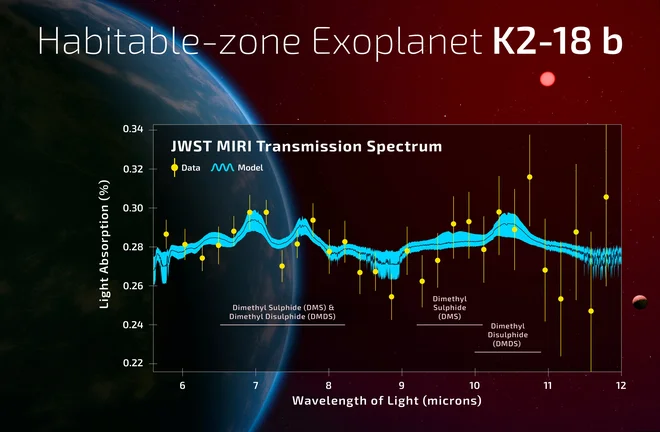The most tangible signal of life on a foreign planet?

The James Webb space telescope detected the chemical compounds that we associate with our lives on Earth on Earth. On a giant planet, which lies 124 light -years away from us, the telescope was detected by Dimethyl sulfide or methyltiomethane (DMS) and Dimethyl Disulfide (DMDS), organic chemical compounds produced by us only living creatures. DMS on Earth is produced as a metabolite in some seaweed and phytoplankton, and DMDS also produce bacteria, fungi, plants and animals. That is why astronomers believe that they may have found one of the most solid evidence that life has evolved elsewhere in space.
« This is the strongest proof of biological activity outside the solar system so far, » he is for Guardian Professor said Nikku Madhusudhanan astrophysicist from the University of Cambridge, who led observations. But in the same breath, we added: “We are very careful. We have to ask ourselves if the signal is true and what it means. «
“In decades, we may look back to this moment and realize that the universe was at our fingertips at the time. This could be a turning point when we could suddenly answer the fundamental question whether we are in space alone, « as it says Guardianadded a researcher.
Graph showing the spectrum of perceived molecules photo: Reuters
Planet K2-18 B is almost nine times more massive than Earth and 2.6 times larger. He circulates around his star in a so -called area suitable for life – that is, an orbit where water could be in liquid state. In our understanding, this is a key component of life. The star that hosts the planet is a red dwarf and is half smaller than the sun. When discovered in 2019 it was discovered by the Hubble Space Telescope, the planet was called « the most appropriate world for life » outside our solar system, they reported in British Guardian. The legendary telescope discovered water vapor in the atmosphere at the time, as well as methane, in 2023 the group of Professor Madhusudhan directed towards the planet even the most powerful astronomical tool of humanity. Webb is equipped with instruments that can analyze the chemical composition of the atmosphere of exoplanets and temperatures, size, density… but these planets are too far away so that even the powerful telescope can be photographed, let alone a space robotic probe.
The findings of a survey published in the magazine Astrophysical Journal Lettersthey show that they have detected much higher concentrations of DMS and DMDS than on Earth, but it is still likely that the compounds are not produced as on our planet. “There may be processes that we just don’t know. However, I think it is not a process that can be explained by the biology, « Madhusudhan added.
The Cambridge team thus believes that there can be a big ocean on the planet, although some other data show that it could be a gaseous giant or even a planet where there are « oceans » of magma, not water. Chemical compounds could occur in volcanic eruptions. A chemist at the University of Berno Nora Hänni, who, among other things, discovered the presence of DMS on a comet where there was certainly no life, said that they had to exclude all other options first, only then to claim that it was a life outside our solar system. Caution in such claims, of course, is never superfluous: many times, researchers have enthusiastically claimed that they had found signals of life, even more pompously, the media then summarized it, but then it turned out that the results could be explained completely differently. For now, we are still waiting for the answer to the famous Drako question: Where are everyone?








:format(webp)/s3/static.nrc.nl/images/gn4/stripped/data133172100-71d860.jpg)